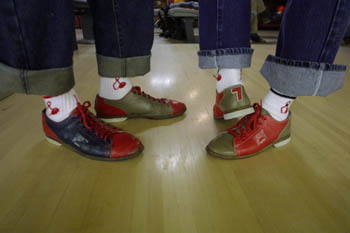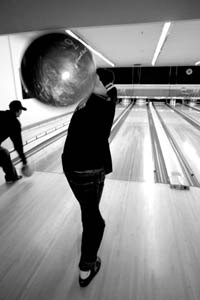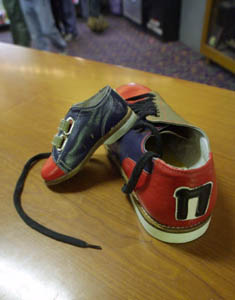![[Metroactive Features]](/features/gifs/feat468.gif)
[ Features Index | Silicon Valley | Metroactive Home | Archives ]
Holy Rolling
Pinning down the real meaning of bowling in post-retro America
By Davina Baum
THIS STORY is about bowling. Not blowing, which is harder on the lungs. Not bowing, which isolates the hips a lot more. Bowling: the people's sport.
I'm not a bowler. I don't bowl. I don't like to bowl. I think it's dumb. Yes, dumb. Weird, even. But I like the sparkly balls; I imagine in my bowling mind that only the sparkly balls will do. I like the way my fingers fit into the three holes, I like the weight of the ball in my hand.
After all, everyone loves bowling. From the beginning of time, practically, people have bowled in some form--bowling historians put the first game at around 3,200 BCE. Invariably, when asked about bowling, people point to how quintessentially American the game is, but variations on the sport have been rolling since well before the Founding Fathers even considered finding anything.
But, like beer and pop music, something that was once the province of Western Europe has been co-opted by the Americans into their own distinctive sport/art form/social contract. Indeed, there are few activities that incorporate mingling and competition, drinking and athleticism in such a tidy package, conveniently down the street at a local strip mall or just off the highway.
The intrinsic goodness, cleanness and funness of bowling hark back to a more innocent time, a time before Americana was sullied by high school shootings, teenage sex and rampant piercings, to a time before Americana was a security risk.
Reports after Sept. 11 have pointed to bowling as the athletic equivalent of comfort food with its promise of a safe place to gather, talk, roll heavy balls. Postdisaster, Americans have bounced back into the idea of community, piling into bowling alleys as if they were bomb shelters. An AP headline from soon after the terrorist attacks read: "Badgerland Bowling Centers of Madison are inviting families to gather Sunday, Sept. 23, to 'Bowl From the Heart,' a fundraiser for the American Red Cross."
Wear Many Faces
I AM EMBARKING upon a quest to learn to enjoy bowling, to bowl from the heart. People don't understand nonbowlers; they're anti-American, anti-fun. I want to fit in. And I like the sparkly balls. Smooth. Round. Sparkly.
I want to be Diana Teeters, professional bowler (www.dteeters.com). She no longer bowls; she was sidelined by bowling injuries. Diana tells me how to prevent bowling injuries: "Learn correct technique from a knowledgeable pro. Do warm-up stretches and cool-down stretches before and after play to keep muscles flexible. Make sure your bowling ball grip fits properly--you should not have to squeeze to hold on to it. Use support devices for the wrist, elbow, or knee if necessary."
I will not do any of these.
I also learn from Diana Teeters, professional bowler, what it takes to be a professional bowler. With the heft of years of experience, this is what she says: "To become a successful professional bowler, you must wear many faces. You must wear the face of a well-trained athlete, an experienced traveler, a courageous warrior, a clever strategist, an eager student, a skilled craftsman and charismatic entertainer. You must also be of strong mind and possess the heart of a lion."
I am a courageous warrior; that much is true. I have to be, to embark on this quest. I will work on the other faces until I have perfected them.
Diana Teeters, professional bowler, also says that selecting the right ball should be based on a matrix, "matching your speed, axis rotation, axis tilt, and revolution with the lane condition." I will have nothing more to do with Diana Teeters, professional bowler; it is my strong belief that selecting the ball should be based on a matrix of color and sparkles.
ACCORDING TO THE International Bowling Museum in St. Louis, Mo., there is evidence that King Henry VIII bowled; Edward III outlawed the sport because it distracted his troops from their archery practice. The historical line of the game continues, splitting off in France as petanque, in Italy as bocce and in England as the very prosaic lawn bowling. The first mention of the game in America appears in Washington Irving's Rip van Winkle.
Bowling got its American start in New York, where Joe Thum ("a jovial tavern owner," according to Harry Smith and Steve Cruchon's optimistic Instant Bowling) coalesced representatives of regional bowling clubs, creating the American Bowling Congress in 1895.
As technology allowed for lighter balls and automated pin changers, the game surged in popularity. Not surprisingly, television assisted in the game's growth; in the 1950s, NBC started to broadcast Championship Bowling. The Bowling Museum asserts that "today, the sport of bowling is enjoyed by 100 million people in more than 90 countries worldwide."
Instant Bowling, published in 1965 and illustrated with many smiling bowlers in pert yet very static hairdos, states that "compared with the kegling hovels of yesteryear, present-day tenpin plants are like ivory-towered Taj Mahals that at once lure and delight. One can see these elegant, million-dollar layouts almost everywhere. They stretch out to as many as a hundred or more lanes in an uninterrupted line, plush sites of refinement and fetching decor, offering every comfort and convenience."
Almost 40 years later, the fetching decor has faded somewhat, and the comforts and conveniences of bowling alleys have expanded to incorporate not only gimmicks to attract bowlers, like Rock & Bowl or Laserlight Bowl, but more pool tables, video games and vending machines than Michael Jackson's manse.
Bowling alleys tend to be either kegling hovels or ivory-towered Taj Mahals erected in the Eisenhower era. The much-vaunted sense of '50s kitsch that many alleys engender is a true inheritor of the '50s, not a paltry, "retro" imitation.
If new alleys were to be built today, they would logically appear in a place like San Francisco's Sony Metreon. The idea is that if classic bowling alleys incorporated video games of every stripe and beep to keep up with what the kids were playing, then it follows (reversely) that modern gaming pavilions would try to include bowling--to capture the nostalgic gamer.
The Metreon's virtual bowling alley, Hyperbowl, is as virtual an approximation of bowling as Michael Jackson is a sex symbol. That is to say, not at all. The joys of tipping the pins, the majestic sound of a ball thundering down the lane, decimating the innocent white pins in its path are barely alluded to.
It's a video game, really. The ball is merely an exalted joystick, attached to a static pedestal, and you "roll" it by pushing it around on its ball bearings, following the action onscreen. There's not much action. There aren't even holes in the balls, and there are no sparkles. I must learn from other masters.
Albany Bowl, in the East Bay, is a better place to start. Albany Bowl could serve as a model for the thousands of bowling alleys across the nation. The combination of lanes, balls, a bar, pool tables, soda machines, video games and hot dog heating devices is repeated again and again throughout the country in some sort of eerie cloning attempt. When you walk into a bowling alley, you know where you are and what lies ahead. It's like Starbucks without the menace of a corporate overlord; Microsoft without the dancing paper clip.
Albany Bowl is a favorite to East Bay dwellers, in part because there are few other alleys in the vicinity (unlike the valley, which boasts almost 15 storied palaces). But it's also famed for having one of the best bars in the Bay Area, balls or no balls. This bar is big, wending its way around a corner between the pool hall and the food pavilion, brightly lit to showcase better the shelves and shelves of soothing liquor.
It is a Wednesday night, and the lanes are all full with people young and old, skinny and fat, all classes, all colors--all bowlers. We (my fearless bowling cohorts and I) buy two games, outfitting ourselves with a pitcher of beer and shoes (red and black, smelling of disinfectant). We approach the lane.
I am nervous and fidgety. I worry that other people are watching me. My nonbowler status is evident, in the way I move, in the halting jerks of my swing, in my careful nonreliance on any of the accepted matrices of ball choice.
We choose balls from the rows of shelves behind the chairs set up in a communal formation around the lane's dauntingly buttoned central control panel. There are no sparkly balls. I choose a purple one, one of the smallest and lightest, although they all seem too heavy.
"Have you found your soulmate?" my friend asks. My soulmate in the ball world must have sparkles. I have not found my soulmate.
We bowl. The balls glide down the lanes as if they're not even rolling, they float over the glossy floors. It's beautiful. (This, note, is not in reference to my balls; my balls disappear down the gutter, in a decidedly rolling fashion.)
I am counseled, to my chagrin, to keep myself low, keep on center. I am shown one bowler's patented four-step delivery; another says to just "do what feels right." What feels wrong is the faces I encounter when retreating from the point of release. Faces that try to show encouragement, with fists raised in victory at the fall of a pin or two. Faces frozen in a rictus approximating a smile of reassurance.
Albany Bowl on this night is a testament to the universal appeal of the game. The lane to our left is occupied by six people in their late-20s--my peers, really--getting their drink on and whooping with the satisfaction of a good shot.
To our right, a mother bowls with her two daughters, aged around 12 and 9. They have the gutter bumpers up, and I'm a little jealous. A little farther down, some Berkeley students are trying to teach two of their friends to bowl. They seem to be enjoying it, however.
Our game continues, interminably. At one point, the ball loses contact with my grip a little early, dropping to the floor on the backswing and rolling backward. Ha. The advice that continues to come out of the mouths of my co-players sounds like the teacher from Peanuts. Wah-wah, wah wah wah-wah. I begin to get angry. "You're catching up, you've got it now!" Piss off.
This game is revealing my true misanthropic nature, and it might break up my relationship. How could I date someone who high fives?
The first game, I bowl a 50. The second game, ostensibly after I'm warmed up and "getting the hang of it" I bowl a 32. This means that I hit an average of 3.2 pins per frame, 1.6 pins per ball. I am terribly glad that the game is over.
MY RESEARCH continues, but I decide that it's better if I do not subject more people to my torture. I bowl alone, leaving work one day to visit three bowling alleys. Three. In the middle of the day.
Bowling alone is a serene experience. It's much easier to bowl without the intrusion of other people. (Herein lies the kernel of truth that is my anti-social nature: People are an intrusion.)
Fourth Street Bowl in San Jose out near the airport is a shiny, comfy place. The monitors above each lane play animated shorts after each ball depicting the pins as alive and happy to be bowled away. At 2pm on a Thursday there are two young guys drinking Coronas, a retired couple and two men bowling alone with big grins on their faces. Without the roaring din of happy bowlers and the invisible eyes watching, judging, I am much more comfortable.
I bowl an 85, and I am pleased with myself. I am the Don Quixote of bowling, picturing myself and my trusty sidekick, Sancho Bowling Ball, slaying the evil, unsuspecting pins in their very homes. I'm doing it all for the lovely Dulcinea.
I move on to Alma Bowl (355 W Alma Ave) in a decidedly better mood about the whole bowling phenomenon. Perhaps I'm not a lost cause, after all. Perhaps I will grow to become one with the ball. Perhaps I should find someone to knight me a bowler errant.
Alma is refreshingly unrefurbished, with a dull pallor to the plastic seats and a serious dearth of colorful balls. I am beginning to doubt the existence of the glowing sparkly ball that was to be my savior, my fellow traveler, my soulmate. Is Sancho Bowling Ball just a dream? I pick a black, heavy ball out of a wall of black, heavy balls. I still do not understand the system of choosing balls. One ball I find has four holes in it, apparently for the six-fingered bowler.
A jovial group of six women and four men is shuffling around, trying to get organized into their game. I see them huddling for a little while before they start choosing their balls, clapping intermittently, and I wonder if they are starting a league, or perhaps a bowling cult. As I am leaving, I ask them what their association is--apparently they all work together and they're bowling as an alternative to a weekly meeting. A bowling retreat of sorts.
It takes me a while to find Cambrian Bowl, buried within the Cambrian Park strip mall between S. Bascom and Union Ave. on Camden Ave. in San Jose. I outfit myself with shoes and a ball that is swirled with green, red and yellow.
After 10 frames it is unclear whether the game is over; there are no flashing lights and the ball just keeps returning to me through its gravity-defying birth canal. But the score does not continue to go up, so I assume that I am done. Mentally, certainly, I am done. I have bowled three games in about two hours. I have a strange sharp pain in my right quadriceps--a bowling injury, no doubt.
Pinned Down
ON THE DAYS that I am not bowling, I am thinking about bowling or talking about bowling. This is not hard to do; everyone has a bowling story. People tell me stories about things like their friend who has a Charlie Chaplin approach (demonstrated for me in a bar); about their highest or lowest score; about the sad demise of the paper scoring system, which made it much easier to cheat.
I discuss with people whether or not ABC still shows pro bowling on Sundays; about the merits of the various alleys and the void in the public consciousness left by the closing of San Francisco's Japantown Bowl. I am inundated with bowling information.
The bowling finale--for me, that is--is at Fiesta Bowl in San Jose, which has very few marks that would distinguish it from any other bowling alley across the country. Fiesta Bowl is packed; in fact there is a serious shoe shortage. One of our team must bowl without the regulation white soles.
We're set up at two adjacent lanes with conflicting tabulation machines; four people dressed in American flag T-shirts bowling in the next lane over clear up the commotion by showing us the complicated arrow system that dictates whose turn is up, and whether they're supposed to be bowling in the left or right lane. When the game is over, people linger to chatter and then disappear into the night.
I have come to the end of my exploration into bowling, and I am glad. I have not enjoyed myself, but I have worn the face of a courageous warrior, as Diana Teeters, professional bowler, advised.
At the entrance to one of the alleys I visited is a bowling supply store, and as I pass by later, I decide to wander through the rows of glossy, expensive balls. They are lovely, I think, but I will never own one of these because they are not sparkly, because my bowling savior has not yet made itself visible to me, like the Virgin Mary in a window reflection, beckoning me to bowling bliss.
Copyright © Metro Publishing Inc. Metroactive is affiliated with the Boulevards Network.
For more information about the San Jose/Silicon Valley area, visit sanjose.com.
![]()

 Rolling Backwards
Rolling Backwards
 Changing Lanes
Changing Lanes
From the January 10-16, 2002 issue of Metro, Silicon Valley's Weekly Newspaper.